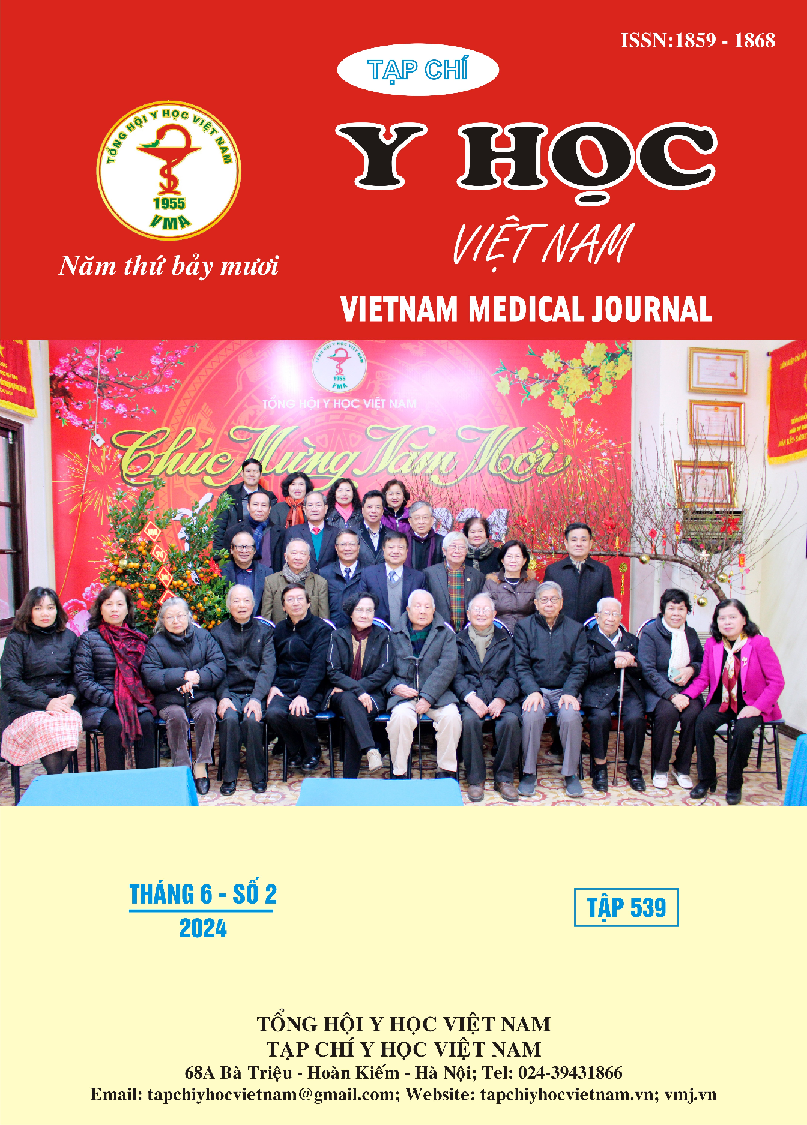CORRELATION BETWEEN PAIN SYMPTOMS AND MAGNETIC RESONANCE IMAGING FINDINGS IN PATIENTS WITH TEMPOROMANDIBULAR JOINT INTERNAL DERANGEMENT
Main Article Content
Abstract
Objective: The aims of this study was to evaluate the correlation between symptoms and severity of temporomandibular joint (TMJ) pain with abnormalities on magnetic resonance imaging (MRI) in patients suspected of TMJ derangement syndrome. Material and methods: Prospective descriptive study at Hanoi Medical University Hospital from 9/2023 to 1/2024 on patients suspected of having TMJ derrangement syndrome. All patients had their pain symptoms and pain level assessed according to the VAS scale, then had a TMJ- MRI scan. Abnormalities on MRI images of the TMJ will be compared to determine the relationship with clinical symptoms and pain levels. Results: A total of 54 patients with 88 TMJ were included in the study, mean age of 27±11.9 years old, the lowest was 11 years old, the highest was 68 years old. There was a strong correlation between symptoms and pain level with abnormal articular disc position (p<0.01, r=0.44), abnormal condyle shape (p<0.01, r=0, 5) and joint fluid (p<0.01, r= -0.5) on MRI. There was a weak correlation between disc shape abnormalities and symptoms and pain level (p<0.01, r=0.29). Conclusion: There was a correlation between symptoms and severity of TMJ pain with articular disc displacement, condyle degeneration and joint fluid in TMJ-MRI.
Article Details
Keywords
Temporomandibular joint disorder, magnetic resonance imaging, Temporomandibular joint pain.
References
2. Paesani D, Westesson P-L, Hatala M, Tallents RH, Kurita K. Prevalence of temporomandibular joint internal derangement in patients with craniomandibular disorders. American Journal of Orthodontics and Dentofacial Orthopedics. 1992;101(1):41-47.
3. Emshoff R, Brandlmaier I, Bertram S, Rudisch A. Relative odds of temporomandibular joint pain as a function of magnetic resonance imaging findings of internal derangement, osteoarthrosis, effusion, and bone marrow edema. Oral Surgery, Oral Medicine, Oral Pathology, Oral Radiology, and Endodontology. 2003;95(4):437-445.
4. Koca CG, Gümrükçü Z, Bilgir E. Does clinical findings correlate with magnetic resonance imaging (MRI) findings in patients with temporomandibular joint (TMJ) pain? A cross sectional study. Medicina Oral, Patología Oral y Cirugía Bucal. 2020;25(4):e495.
5. Rammelsberg P, Pospiech PR, Jäger L, Duc J-MP, Böhm AO, Gernet W. Variability of disk position in asymptomatic volunteers and patients with internal derangements of the TMJ. Oral Surgery, Oral Medicine, Oral Pathology, Oral Radiology, and Endodontology. 1997;83(3):393-399.
6. Murakami S, Takahashi A, Nishiyama H, Fujishita M, Fuchihata H. Magnetic resonance evaluation of the temporomandibular joint disc position and configuration. Dentomaxillofacial Radiology. 1993;22(4):205-207.
7. Ege B, Kucuk AO, Koparal M, Koyuncu I, Gonel A. Evaluation of serum prolidase activity and oxidative stress in patients with temporomandibular joint internal derangement. CRANIO®. 2019;
8. Taşkaya-Yılmaz N, Öğütcen-Toller M. Magnetic resonance imaging evaluation of temporomandibular joint disc deformities in relation to type of disc displacement. Journal of oral and maxillofacial surgery. 2001;59(8):860-865.
9. Segami N, Nishimura M, Kaneyama K, Miyamaru M, Sato J, Murakami K-I. Does joint effusion on T2 magnetic resonance images reflect synovitis? Comparison of arthroscopic findings in internal derangements of the temporomandibular joint. Oral Surgery, Oral Medicine, Oral Pathology, Oral Radiology, and Endodontology. 2001;92(3):341-345.
10. Takahara N, Nakagawa S, Sumikura K, Kabasawa Y, Sakamoto I, Harada H. Association of temporomandibular joint pain according to magnetic resonance imaging findings in temporomandibular disorder patients. Journal of Oral and Maxillofacial Surgery. 2017;75(9):1848-1855.


